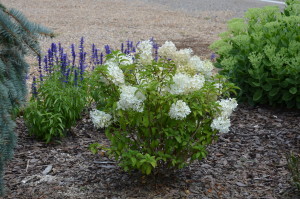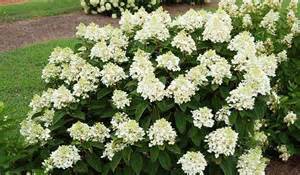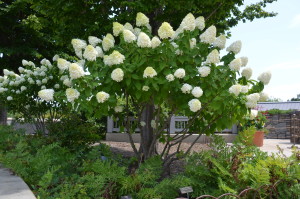Panicle, PeeGee or PG hydrangeas (Hydrangea panculata) brighten up your July-August garden. They hail from China and Japan and grow almost anywhere in the U.S. (USDA hardiness zones 3 – 8). PG hydrangeas are far more reliable in northern areas (zones 3-5), than mophead hydrangeas (H. macrophylla). They flower at their best in full to partial day sunlight (6 hours or more).
PG hydrangeas are vigorous growers. Branching is upright and their deciduous foliage is coarse textured. Depending on cultivar, PG hydrangeas grow 3-15 feet, and 20-25 feet tall in tree form. Multi-branched shoots are clothe with dark green, oval shaped leaves and are topped with upright, sharply-pointed, conical, 6-8 inch long terminal flower panicles. Flowers may be a mix of both fertile and sterile florets and bloom from mid-summer into fall. PG hydrangeas are pruned any time from late fall to mid-spring. They may also be trained into a tree form.
Most gardeners are well acquainted with the popular cultivar Limelight™, the standard for excellence in PG hydrangeas. Limelight grows 6-10 feet tall (depending on amount of annual pruning provided). Its sturdy upright branched are covered with 6-8 inch long, conical shaped white flowers. Blooms make beautiful fresh or cut flower arrangements.
Four “new” panicle hydrangeas for planting in small gardens and in containers:
Baby Lace® – petite, lacy white blooms against dark green foliage. Its smaller size of 3 by 5 feet .
Bobo™ – grows very compact size, the perfect size in small gardens and containers; large white loose flowers appear from midsummer to early fall.
‘Bombshell’ – is dwarf (compact) form with abundant star-shaped sterile flowers with elliptic sepals, dense nearly round flower panicles, and free blooming habit. It blooms earlier and longer than most other panicle hydrangeas. Flowers emerge white and slowly turn rosy pink. Strong stiff stems hold the flower panicles upright with no drooping.
Little Quickfire® – is a shorter of Quickfire, growing 3-5 feet tall with creamy spikes that turn to deep pink with red highlights on bold, red stems.
Bacterial wilt, leaf spot, rust, and mildew diseases and aphids and mites are occasional disease and insect problems. Poor site selection often enhances problems with diseases and pests.




 Posted in
Posted in 
